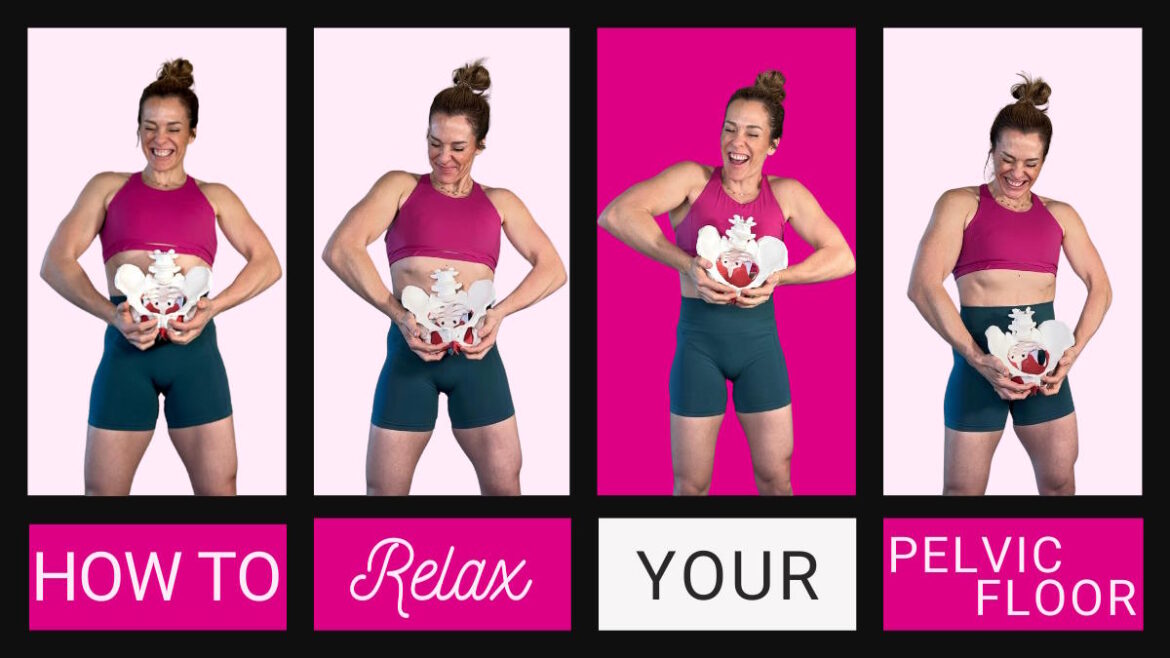One of the most important touchstones of pelvic health is the ability to relax your pelvic floor.
Learning to relax your pelvic floor is just as important as learning to contract it. Yet many women don’t understand the importance.
A tight pelvic floor can lead to a host of issues. Symptoms include pelvic, hip, or back pain, incontinence, constipation, leaking or trouble emptying your bladder, pain during sex, and even anxiety.
Why Does Pelvic Floor Relaxation Matter?
A tight, or hypertonic pelvic floor means the pelvic floor muscles are overactive, maintaining tension even when they should relax. This can lead to the health issues mentioned above, which can be disruptive to everyday mom life. While data is limited, it suggests that one out of every ten people with a pelvic floor dysfunction have a tight pelvic floor. You are not alone.
Fortunately, you can improve signs and symptoms. So, how do you relax your overactive pelvic floor muscles?
Pelvic Floor Relaxation Exercises
You can start with adjusting the way you breathe – a simple but important change. You should also incorporate functional movement, like yoga and mobility exercises, into your routine to relax the pelvic floor and stretch the muscles surrounding the pelvis and abdomen.
Like any muscle, the pelvic floor functions best when it can both relax and contract.
It can be hard to learn to relax and lengthen the pelvic floor muscles, but it’s worth it.
Here are some of my favorite exercises to help with the condition:
Pelvic Floor Breathing Exercise
How you breathe ties directly to pelvic health. Many people have a habit of breathing into their chests, often because they are trying to suck in their stomachs. This is the opposite of how our bodies are designed.
Your diaphragm and pelvic floor work together much like a piston on a train. As you inhale, the dome-shaped diaphragm pushes air down into your body. When you exhale, your pelvic floor relaxes and releases.
Proper diaphragmatic breathing promotes optimal muscle function and can help decrease pain:
- Sit comfortably in a chair or lay on the floor with your knees bent and feet up on a chair, for example. Place a hand on your chest and the other on your abdomen.
- Inhale down into your body, expanding your rib cage like an umbrella. Overflow air will flow gently into your tummy. You should feel abdominal muscles move, while the hand on your chest remains still.
- As you exhale, your pelvic floor will naturally recoil and release.
Practice full belly breathing daily – check in with yourself. Ideally, you will get into the habit of breathing down into the belly all the time. I can’t stress how important this is.
Diaphragmatic breathing has numerous other benefits. In addition to helping the pelvic floor go through its full range of motion, it also helps you poop! It can relieve constipation by massaging your intestines and moving things along.
Slow, deep breathing promotes muscle relaxation and can help reset your nervous system and improve anxiety.
Practice Visualization
The mind-muscle connection with the pelvic floor is so important. As you inhale down into your body, try one of the following cues to help bring your pelvic floor to its resting state.
Imagine:
- A flower opening
- A trap door opening
- A wave rolling out
- An elevator going down
Child’s Pose
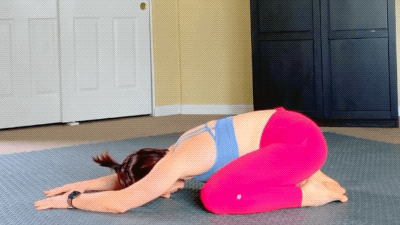
- Kneel with legs spread wide, then relax your body forward toward the floor. Rest your forehead on the floor or on your hands if it cannot reach.
- Sit your hips back and let your low back naturally “open.” You can also use your hands to actively open and release your glutes.
- Take slow, deep breaths. Imagine your tailbone spreading apart as you inhale.
Deep Squat
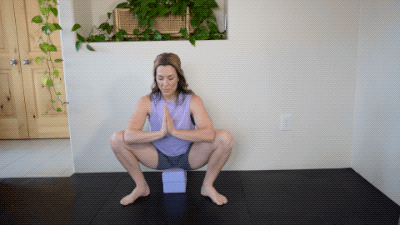
- Set up a yoga block(s) or a couple of pillows under you. Take a nice, wide stance and sit down, to relax.
- Keep your chest as upright as you can. Let your tummy go!
- Inhale deeply through your nose and feel the breath go down as your pelvic floor “opens” into the pillow. As you exhale, your pelvic floor will naturally recoil.
Happy Baby
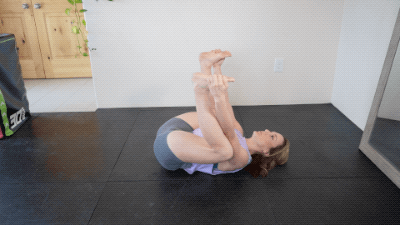
This is a great movement to do one side at a time because we all have imbalances. Your pelvic floor can also be tighter on one side.
- Lay on your back and pull one leg up, knee aiming toward shoulder, and foot flexed parallel to the ceiling.
- Grab your foot and pull it down to open your hips. Breathe in slowly through your nose and imagine your pelvic floor opening.
- Repeat on the other side.
Cat Cow
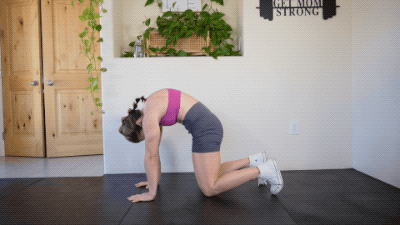
- Get on all fours, with your hands under your shoulders, hips and knees aligned.
- Inhale through your nose into your body as you let your tummy relax, looking toward the ceiling.
- Exhale audibly as you press your palms into the floor, arch back, and tuck your pelvis.
- Relax and repeat.
Reclined Figure Four
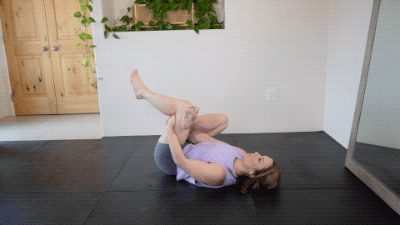
- Lie on your back and cross your right ankle over your left thigh. Grab a hold of your left hamstring, pulling the leg up toward your body.
- Keep your right foot flexed to protect your knee, as you begin to – you guessed it – breathe in deeply through your nose.
- Use your right arm/elbow to help push your right knee out as you gently pull the left leg in for a deeper stretch.
- Repeat on the other side.
Should I Seek Care?
Be patient – it takes time to improve the symptoms of a hypertonic pelvic floor. But no one should have to suffer from pelvic pain. If the symptoms you’re experiencing are unmanageable, please see a doctor or seek out a pelvic floor physical therapist in your area. Also, check out our SLAM Stretch program for some great pelvic floor relaxation and release work.
The great news is that learning to relax your pelvic floor can help relieve pain with sexual intercourse, improve your bowel movements, relieve hip and back pain, and even remedy incontinence.
